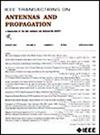具有增强隔离和灵活频率比调节的紧凑型双频辐射共享天线
IF 4.6
1区 计算机科学
Q1 ENGINEERING, ELECTRICAL & ELECTRONIC
引用次数: 0
摘要
在这种通信中,提出了一种具有增强隔离,灵活频率比(FR)调节和紧凑尺寸的散热器共享双工天线(RSDA),用于多频段/标准通信系统。该散热器共享设计基于一种整形方案,利用寄生谐振器使低频段(LB)和高频段(HB)天线具有相同的辐射结构。采用定制的馈电方法分别激发高阶衬底集成波导(SIW)腔模式和分数阶贴片模式,实现双频工作,并允许从1.3到1.7的灵活FR调节。所提出的RSDA消除了去耦结构或额外的双工/滤波电路的需要。通过利用分层馈电结构、屏蔽侧壁和高通SIW馈线分别抑制馈线耦合、表面波干扰和带外信号传播,实现了超过24 dB的隔离增强。为了验证,对RSDA的原型进行了测量,展示了双宽带操作,包括目标5G/Sub 6G n78频段(3.3-3.6 GHz)和n79频段(4.8-5 GHz)。该样机在3.45 GHz和4.95 GHz时的峰值增益分别为5.3 dBi和7.4 dBi,同时具有超过53 dB的高隔离电平和良好的辐射方向图。本文章由计算机程序翻译,如有差异,请以英文原文为准。
A Compact Dual-Band Radiator-Shared Antenna With Enhanced Isolation and Flexible Frequency Ratio Regulation
In this communication, a radiator-shared duplex antenna (RSDA) with enhanced isolation, flexible frequency ratio (FR) regulation, and compact size is proposed for applications in multiband/standard communication systems. The radiator-shared design is based on a shaping scheme by utilizing a parasitic resonator to make the lower band (LB) and higher band (HB) antennas have the same radiation structure. Customized feeding methods are employed to individually excite the high-order substrate integrated waveguide (SIW) cavity mode and the fractional-order patch mode, enabling dual-band operation and allowing a flexible FR regulation from 1.3 to 1.7. The proposed RSDA eliminates the need for decoupling structures or additional duplexing/filtering circuits. Isolation enhancement of over 24 dB is accomplished by exploiting the layered feeding architecture, shielded sidewalls, and a high-pass SIW feedline to suppress the feedline coupling, surface wave interference, and out-of-band signal propagation, respectively. For verification, a prototype of the proposed RSDA was measured, demonstrating dual-wideband operation that encompasses the targeted 5G/Sub 6G n78 band (3.3–3.6 GHz) and n79 band (4.8–5 GHz). The prototype achieved a peak gain of 5.3 dBi at 3.45 GHz and 7.4 dBi at 4.95 GHz, while exhibiting a high isolation level exceeding 53 dB and good radiation patterns.
求助全文
通过发布文献求助,成功后即可免费获取论文全文。
去求助
来源期刊
CiteScore
10.40
自引率
28.10%
发文量
968
审稿时长
4.7 months
期刊介绍:
IEEE Transactions on Antennas and Propagation includes theoretical and experimental advances in antennas, including design and development, and in the propagation of electromagnetic waves, including scattering, diffraction, and interaction with continuous media; and applications pertaining to antennas and propagation, such as remote sensing, applied optics, and millimeter and submillimeter wave techniques

 求助内容:
求助内容: 应助结果提醒方式:
应助结果提醒方式:


